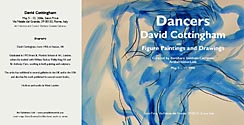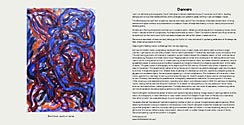


| David Cottingham Dancers | ||||
 | ||||
 |
 |
 |
||
 |
||||
 | ||||
 | ||||
 | ||||
|
Dancers
Lost in an exhilarating choreography, David Cottingham’s dancers celebrate the joy of movement and rhythm, bending, swinging and turning their bodies skillfully, striking energetic and powerful poses, twirling in light and elegant moves. The effortless and smooth flow of gestures requires utter body control from the dancer, a focussed concentration of force; practise and regular workout are preconditions to create an illusion of weightless floating in the air, leaving the ground and escaping gravity. Sometimes in flaming compositions worked up in successive layers, reflecting a whole sequence of progressing moves, sometimes in reduced studies of a single pose, the shape accentuated by colour: David Cottingham’s dancers are filling the canvas, conquering it by their continuous rhythmical steps and gestures, taking their places in space and time. Dance as an expression of body and soul, taking up the rhythm of music and sound in a pulsating celebration of life always has been a fascinating subject to artists. Capturing this fleeting motion: a challenge from the very beginning. But how to transfer motion, progressing movement tied to time, in static media, only able to catch and show a single moment, a glimpse out of a complex process? How to record spontaneity? The attempts have been various throughout time. The wild waving garments and scarves of maenads in ancient reliefs indicated the unleashed passion of their untamed dance while escorting Dionysus, the Greek God of wine. Flapping vesture turned into a binding term for defining dance and movement in art for a long period of time. In modern painting, artists focussed on colour as suitable vehicle for sensations, using its synaesthetic power to evoke visual and audible impressions at the same time and thus create an approximation to the reality of dance. The great impact of photography at the beginning of the 20th century influenced many artists; it opened a new view on movement. The experimental method of fixing the course of motions in so called kinetography used very long exposure times. A single photograph thus revealed every single step of a developing movement, apparently juxtaposing every single gesture in successive layers, the same person appearing in infinite multiplications. The visualisation of movement in slow-motion gave birth to new ways of painting and provided the basis for scientific analysis of dance used by choreographers up to now. Duchamp, fascinated by the possibilities of kinetography, adopted this method for his painting work in the early 1920s, showing a nude descending the stairs, recording every step in a simultaneous picture. With this technique of depicting motion, waving clothes demonstrating the movement of its bearer turned superfluous, the very essence of dance moves since can be traced without mediating elements. The body became the main instrument of expression, transforming individual internal sensations but also prevailing performing fashion to sublime expression. David Cottingham combines the power of colour with dynamic figurative drawing. Always aware of painting tradition and the history of photography, in close reference to many modern artists from Degas through Rodin to Matisse, he is inspired by their effort to catch the unseizable beauty of pure movement, whether in figurative or abstract attempts. He adopts Abstract Expressionist methods of applying the flow of paint on canvas, the spontaneous gesture painting. While observing the dancers moving to classical or contemporary music, David Cottingham traces their shapes and moves according to their progress in real-time, intuitively taking up the constant stream of motion in his way of painting, letting his brush dance over the canvas, following every improvisation, every smooth or sudden change of pose, every nuance of tempo... Dance and painting: a synchronous work in progress.
ArtExhibitionLink |
||||
 | ||||
 | ||||
 | ||||
| View the Work | ||||
 | ||||
 | ||||


